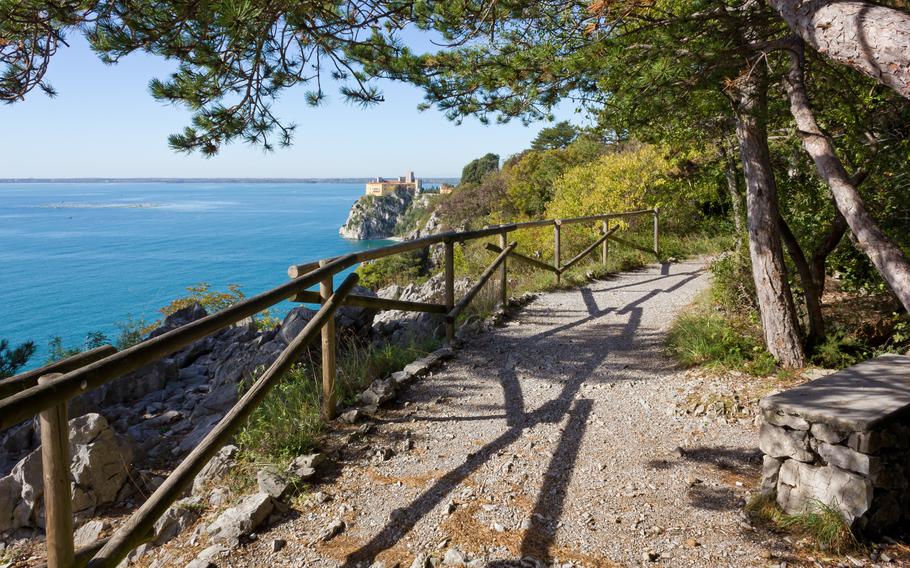
The Rilke Trail, about 12 miles north of Trieste, Italy, is a scenic tribute to 20th century modernist poet Rainer Maria Rilke. (iStock)
Through its art, music, cultural norms or culinary traditions, the soul of a nation expresses itself in countless ways. Here are events, landmarks and landscapes through which we can connect with a handful of Europe’s most highly regarded authors and poets.
Burns Night in Scotland
Robert Burns, also known as Rabbie Burns, is hailed as the national poet of Scotland. Each year on or around his birthdate of Jan. 25, Scots at home and around the world host or attend a Burns Supper. In a tradition that first played out in the place of Burns’ birth on the fifth-year anniversary of his passing, friends gather for food, drink and the recitation of Burns’ immortal words. Following a first-course of soup, mashed potatoes and turnips are served as sides to the centerpiece of the meal, a haggis, brought to the table to the accompaniment of bagpipes and followed by toasting and the reciting of set verses.
With Burns Societies alive and well – some 250 of them exist around the world – one does not have to travel to Scotland to experience a Burns Supper. While arguably the most traditional of Burns Nights plays out in his cottage in Alloway, now the Robert Burns Birthplace Museum, just south of Ayre, pubs and restaurants across the land host Burns Nights. For an upscale experience, consider attending the Burns Supper aboard the Royal Yacht Brittania, at anchor in Leith, just outside Edinburgh. The evening consists of a pipes-and canapé reception, followed by a five-course meal, a tour of the State Apartments, whisky tasting and more. Tickets to the event set for Jan. 24 or 25 go for 245 UK pounds (about $316) per person. For other options in and around Edinburgh, see tinyurl.com/3vceapwm.
Bloomsday in Dublin
In 1922, James Joyce penned the modernist novel Ulysses, a story portraying ordinary people going about their everyday business. The day in question – 16th June, 1904 – is known nowadays as Bloomsday, a name it takes from one of the novel’s main characters. The novel follows a day in the life of Leopold Bloom as it intertwines with others from one morning to the next. Each year on June 16, fans of the book endeavor to bring the spirit of this time to the streets of Dublin through readings, reenactments, guided tours and not least, dressing up like the characters in the novel would have done. Leading this flurry of activity is The James Joyce Centre, a museum dedicated to the writer set in an 18th-century townhouse located in Dublin’s historical Georgian quarter. With close to 100 events occuring in the weeks and days prior to June 16, Bloomsday’s scope and specific focus is considered a literary and cultural festival without parallel. Online: bloomsdayfestival.ie
Hans Christian Andersen in Odense, Denmark
The Danish author Hans Christian Andersen turned out plays, travelogues, poems and full-blown novels, yet he is best remembered for his ability to spin a fairy tale. Since 2013, his hometown of Odense has hosted a late-summer festival in his honor. The Hans Christian Andersen Festival consists of all the theatrical performances, lectures, guided tours and costumed characters one would expect while keeping in mind its core audience, children, who can enjoy games, storytelling sessions and workshops fostering their creativity. Some ninety percent of the festivals hundreds of activities are free. The Hans Christian Andersen Festival traditionally take places during Week 34, corresponding to the dates of Aug. 18-24 in 2025. Online: hcafestivals.com
Astrid Lindgren’s World in Småland, Sweden
While US readers might only recognize the pigtailed redhead mischief-maker Pippi Longstocking, the children’s author Astrid Lindgren created dozens of other whimsical characters known and loved by young readers around the world. In the heart the province of Småland in southern Sweden, close to the author’s childhood home, Astrid Lindgren’s World is a vast playground and stage for dozens of performances given on a daily basis throughout the summer. Once they tire from exploring Pippi’s home, the Villa Villekulla, families can picnic beneath the very oaks where the author played as a child or take in regional cuisine at one of the park’s restaurants. “Astrid Lindgrens Värld” in the town of Vimmerby is open daily from mid-May through late August, as well as on weekends and the autumn school holidays. Online: astridlindgrensvarld.se/en
Rainer Maria Rilke in Trieste, Italy
Rainer Maria Rilke, considered one of the most influential modernist poets of the 20th century, was born in Prague (then part of Austria-Hungary), had Austrian citizenship, and wrote in the German language. From 1911-1912, he lived in the Duino Castle overlooking the Adriatic Sea, a location referred to in his collection of poetry called the Duino Elegies. The Sentiero Rilke, or Rilke Trail, found some 12 miles north of Trieste, is a roughly mile-long, mostly flat hike overlooking a stunning bay. The trail, which leads to the Sistiana Nature Reserve, runs across white karst cliffs, created from the shells of tiny living creatures deposited upon a bed of shallow sea. While walkers are bound to be mesmerized by the stunning views that inspired Rilke’s works, English-language information and excerpts from Rilke’s writing is thin on the ground here, so doing some research beforehand is bound to enhance the experience. Online: tinyurl.com/5n8wf532